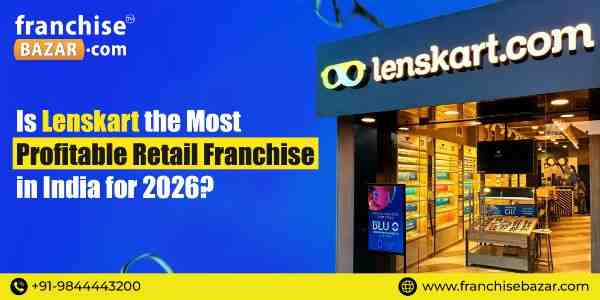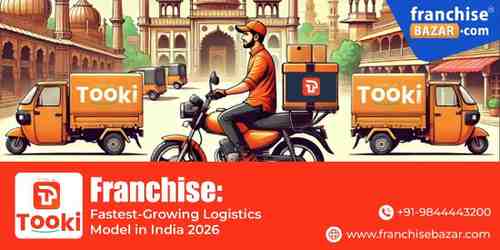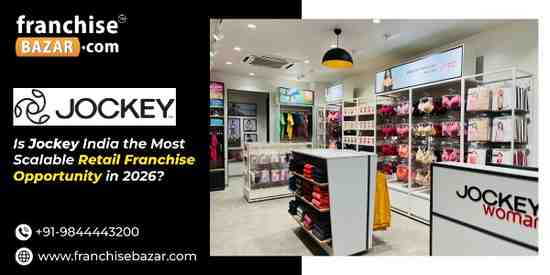Is Lenskart the Most Profitable Retail Franchise in India for 2026?

Written By: Khushboo Verma
India’s retail landscape has changed sharply over the past decade, and eyewear has been one of the fastest-growing categories. Consumers today buy spectacles and sunglasses not just for necessity but also for style, work, screen protection, and convenience. This shift has pushed organised eyewear brands to scale rapidly, and one name consistently stands out – Lenskart. For investors assessing retail opportunities in 2026, the main question is simple: Is Lenskart the Most Profitable Retail Franchise in India for 2026?
As interest in organised eyewear continues to rise, evaluating Lenskart’s franchise model has become even more relevant. It outlines the market landscape, investment structure, and the operational factors that ultimately influence long-term store performance.
Why Lenskart Dominates Eyewear Retail Franchise Industry
The Indian eyewear market was valued at USD 10.4 billion in 2024 and will reach USD 19.6 billion by 2033, growing at 6.94% annually. Within this expanding market, Lenskart has captured dominant market share through strategic advantages.
Why Eyewear Retail Works:
- Essential Category: Eyewear is not discretionary spending. People need glasses regardless of economic conditions, making them recession-resistant.
- Repeat Purchase Cycle: Spectacle users replace eyewear every 12-18 months. This creates predictable recurring revenue that apparel or electronics cannot match.
- Digital Device Usage: Urban Indians spend 6-7 hours daily on screens. Blue-light glasses have become a mainstream necessity.
- Shift to Organized Retail: Customers prefer branded stores offering warranties and digital eye tests over local optical shops. This transition creates expansion opportunities.
Why Lenskart Leads This Franchise Category:
Lenskart combines online convenience with physical retail strength. The brand operates 2,300+ stores in India with unique advantages: AI-powered virtual try-on, home eye-check services, in-house manufacturing at Bhiwadi, and same-day delivery in select cities. Additionally, founder Peyush Bansal's Shark Tank India presence drives organic brand awareness without heavy marketing spend.
Therefore, the Lenskart franchise benefits from both category fundamentals and brand-specific strengths.
Lenskart's Financial Performance
As of FY 2025, Lenskart operates over 2,300 stores across India and 300 internationally, serving 9.9 million active customers. Revenue grew 23% year-on-year to ₹6,653 crore in FY25, with profit after tax reaching ₹297 crore. This marked the company's first full-year profitability.
For franchise partners, this scale means reliable supply chains, high brand recall, strong backend support, and proven profitability at the unit level.
Lenskart Franchise Investment Breakdown
The total investment ranges from ₹15-30 lakh depending on location and city tier.
|
INVESTMENT COMPONENT |
Amount |
INVESTMENT COMPONENT |
Amount |
|
One-Time Setup Costs |
Monthly Operating Costs |
||
|
Store Interiors & Fixtures |
₹10-15L |
Rent |
₹50-80K |
|
Eye Testing Equipment |
₹3-5L |
Staff Salaries |
₹70-90K |
|
Initial Inventory |
₹10-12L |
Utilities |
₹10-15K |
|
Branding & Signage |
₹2-3L |
Marketing |
₹8-12K |
|
Technology & POS |
₹2-3L |
Miscellaneous |
₹10-15K |
|
Franchise Fee |
₹2-5L |
|
|
|
TOTAL |
₹15-30L |
TOTAL |
₹1.5-2.1L |
- Space Required: 300-500 square feet in malls, commercial streets, or residential areas.
- Critical Advantage: No monthly royalty fees. Franchisees earn through product margins.
Profitability Analysis
Revenue and Margins: Daily sales range from ₹6,500 to ₹13,500, generating monthly revenue of ₹2-4 lakh.
Product Margins:
- Prescription Frames: 25-30%
- Sunglasses: 35-40%
- Contact Lenses: 15-20%
- Accessories: 40-50%
Profit Expectations
Most franchise owners achieve profit margins of 25-30%, generating monthly net profits of ₹1.2-2.5 lakh. Breakeven typically occurs within 9-12 months, with full ROI achieved in 18-24 months.
Figures vary by location and operational efficiency
Profitability Comparison Within Eyewear Category
To determine if the Lenskart franchise is truly the most profitable, we must compare it with direct competitors in eyewear retail.
|
Eyewear Franchise |
Investment |
Net Margin |
Breakeven |
Brand Strength |
Key Insight |
|
Lenskart |
₹15-30 lakh |
25-30% |
9-12 months |
Very High |
Moderate investment, zero royalty, national presence |
|
Titan Eye Plus |
₹30-50 lakh |
25-35% |
12-18 months |
Very High |
Tata backing but higher investment barrier |
|
Specsmakers |
₹10-20 lakh |
25-35% |
10-14 months |
Medium |
Lower investment but limited to South India |
|
GKB Opticals |
₹20-35 lakh |
20-30% |
12-15 months |
Medium |
Eastern India focus, moderate brand presence |
|
Himalaya Opticals |
₹15-25 lakh |
25-35% |
10-14 months |
Medium |
Good margins but regional limitations |
Lenskart's Competitive Edge: Balances moderate investment with strong national brand presence, technology integration, zero royalty structure, and proven profitability across India.
Lenskart Eyewear vs Other Retail Franchise Segments
Beyond eyewear competition, how does this category compare with other retail franchise opportunities?
|
Retail Category |
Investment |
Net Margin |
Breakeven |
Seasonality |
|
Eyewear (Lenskart) |
₹15-30 lakh |
25-30% |
9-12 months |
Low |
|
FMCG (Amul) |
₹2-6 lakh |
15-20% |
6-9 months |
Low |
|
Apparel (Zudio) |
₹50-90 lakh |
12-18% |
24-36 months |
High |
|
QSR (Domino's) |
₹1.5-3 crore |
15-20% |
24-30 months |
Moderate |
|
Baby Products (FirstCry) |
₹30-50 lakh |
15-22% |
18-30 months |
Moderate |
Why Eyewear Wins
- Higher Margins: Eyewear delivers 25-30% net margins, outperforming apparel (12-18%) and QSR (15-20%).
- Lower Seasonality: Unlike apparel or baby products, eyewear demand remains stable year-round. No festival dependency.
- Faster Breakeven: Eyewear breaks even in 9-12 months compared to 24-36 months for apparel or QSR.
- Moderate Investment: Lower than QSR (₹1.5-3 crore) or premium apparel (₹50-90 lakh), making it accessible.
- Essential Category: People need glasses regardless of trends or economic cycles. This recession-resistance is rare in retail.
Why Lenskart Stands Out for Profitability
1. Essential Product Category
Eyewear remains a necessity. People need glasses regardless of economic cycles, making the business recession-resistant. This stability is rare in retail.
2. Zero Monthly Royalty
Most franchises charge 5-8% royalty on gross sales. This eats into franchisee profits. Lenskart's margin-based model eliminates this burden, keeping earnings stable and predictable.
3. Strong National Brand Recognition
Peyush Bansal's national television presence through Shark Tank India significantly increased brand visibility. This drives organic footfall without requiring heavy local marketing budgets.
4. Technology Integration
AI-powered fitting tools, home eye tests, and virtual try-on increase conversion rates. Technology reduces product returns and improves customer satisfaction, directly impacting profitability.
5. Proven Profitability Track Record
Lenskart's shift from losses to ₹297 crore profit in FY25 demonstrates strong unit economics and a scalable business model. This validates the franchise opportunity.
6. Comprehensive Support System
Franchisees receive:
- Complete store design and setup assistance
- Staff training programs
- Centralized inventory management
- National marketing campaigns
- Real-time performance analytics
- Ongoing operational support
This support reduces execution risk for franchise partners.
7. Recurring Revenue Model
Most spectacle users replace glasses every 12-18 months. This creates predictable repeat business that apparel, electronics, or furniture franchises cannot match.
Challenges Every Investor Must Consider
Every business has challenges. Here are the main ones for the Lenskart franchise:
- Initial Investment Requirement: ₹15-30 lakh may be steep for first-time entrepreneurs, though it is competitive within the eyewear category.
- Optometrist Availability: Hiring qualified optometrists can be difficult in smaller cities. Service quality depends on skilled staff, affecting customer trust and repeat business.
- Location Criticality: Prime locations have higher rents. Poor locations struggle with footfall, directly impacting revenue and profitability timelines.
- Competition: Local optical stores and brands like Titan Eye Plus compete for the same customers. Differentiation through brand strength and technology matters.
- Inventory Management: Managing stock requires discipline. Slow-moving inventory ties up capital and reduces returns. A centralized supply chain helps but requires active management.
- Breakeven Timeline: While 9-12 months is competitive, investors seeking faster returns may find this challenging.
Key Profitability Drivers
Success depends on several controllable factors:
- Location Quality: High-traffic areas generate consistent footfall. Mall locations perform better but cost more in rent. High streets in residential areas offer good balance.
- Optometrist Quality: Qualified staff improves customer experience and drives repeat purchases. Investing in good talent pays dividends.
- Conversion Rate: Well-trained sales staff and good product displays increase conversion. Store ambiance matters in premium eyewear sales.
- Product Mix: Balancing prescription frames, sunglasses, contact lenses, and accessories maximizes margins. Avoid over-reliance on any single category.
- Operational Efficiency: Minimizing waste, managing inventory turnover, and controlling operating costs directly impact net profitability.
- Seasonal Leverage: October to February sees higher sales due to festivals and weddings. Maximizing this period accelerates ROI.
Who Should Invest in This Franchise?
The Lenskart franchise works well for:
- First-time retail investors seeking proven models
- Entrepreneurs wanting stable, recurring revenue
- Investors with ₹15-35 lakh available capital
- Property owners in high-traffic areas
- Professionals seeking semi-managed businesses
- Those comfortable with 18-24 month ROI timelines
It may not suit:
- Investors seeking returns within 6 months
- Those wanting daily hands-on involvement
- Entrepreneurs looking for creative or F&B ventures
- Risk-averse investors uncomfortable with retail dynamics
Application and Setup Process
Interested investors follow these steps:
- Visit Official Website: Access Lenskart's partner portal
- Submit Application: Fill franchise inquiry form with location details and financial capacity
- Initial Screening: Company reviews application and proposed site
- Site Evaluation: Lenskart team assesses location viability and foot traffic
- Agreement Signing: Finalize investment terms and timelines
- Store Setup: 45-60 days for complete setup with company support
- Staff Training: Comprehensive training provided for operations and sales
- Grand Opening: Launch with marketing support
Final Verdict: Is It the Most Profitable?
Based on investment requirements, profit margins, and competitive analysis, the Lenskart franchise ranks among the top profitable opportunities in India for 2026.
Key Strengths:
- 25-30% profit margins
- Zero monthly royalty
- 9-12 months breakeven
- Strong national brand
Considerations:
- ₹15-30 lakh investment needed
- Location critical for success
- Requires qualified optometrist
The Lenskart franchise offers stable demand, strong unit economics, and proven profitability. For investors seeking reliable retail business with moderate investment and fast breakeven, this represents a compelling opportunity.
However, conduct thorough due diligence, visit existing stores, and consult financial advisors before investing.
Disclaimer: The brands mentioned in this blog are the recommendations provided by the author. FranchiseBAZAR does not claim to work with these brands / represent them / or are associated with them in any manner. Investors and prospective franchisees are to do their own due diligence before investing in any franchise business at their own risk and discretion. FranchiseBAZAR or its Directors disclaim any liability or risks arising out of any transactions that may take place due to the information provided in this blog. For more such opportunities, visit us on our Insta and FB
Recent Blogs

Written By: Khushboo Verma
India’s...

Written By: Harsh Vardhan Singh
The biggest...

Written By: Gouri Ghosh
Every parcel in India...

Written By: Bandana Gupta
India’s...
Why Should I Register?
You are seeking to access information which is provided only to registered members. It takes less than a minute to register and access information on FRANCHISEBAZAR.